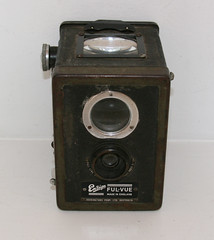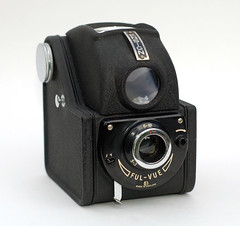Ensign Ful-Vue

|
| Ful-Vue, the alternate British box camera design with the big viewfinder, introduced by Barnet Ensign in 1945. |

|
| Early Ful-Vue: already with the big finder |
cit: "The Ful-Vue camera is really a very simple camera. It consists of a light-tight box. In front of the box there is a hole, over which the lens is fixed. Behind this whole is the shutter. There is a second lens in a second box above it. This produces a picture on the viewfinder on top of the camera. In the back of the box is another hole covered by a red window. This helps you in winding the film on, which you do by the knob at the side of the box near the top." [Marcel Natkin].
The earliest Ful-Vue version of 1939 was a typical box camera with back door, but already having the characteristic big viewfinder. Like other box cameras it had a back door and an inner camera part which could be taken out of the box to load the film. In 1945 the camera was redesigned, getting away from average box camera design. Then the inner part of the camera was fixed to the side panel with the film winding knob. The whole unit could be pulled out of the camera sidewards after unlocking it with the knob on the other side panel.
Shutter speed is 1/30 sec. in instant mode and B in time mode. Focusing is possible by pulling the lens out for close exposures. Pictures are 6x6cm on 120 film.
In 1950 further improvements were made, the new shutter, three distance settings, an all plastic front panel, and flash synchronization. The improved version was called Ful-Vue II. This was succeeded in 1954 by the Ross-Ensign Ful-vie Super, which had a flat front plate extending around both lenses, a cast alloy body (in place of the sheet steel) and a folding hood around the viewfinder. The Super used 620 film.

|
| 1950s version, with plastic front and distance scale |
Links
- the Ful-Vue at www.ensign.demon [1]
- Full-Vue and User manual at www.collection-appareils.com
- Flickr Group ful-vue
Literature
- Natkin, Marcel: Ful-Vue Guide. London and New York 1949 (2nd. edition 1951, 3rd ed. 1952., 4th ed. 1953)